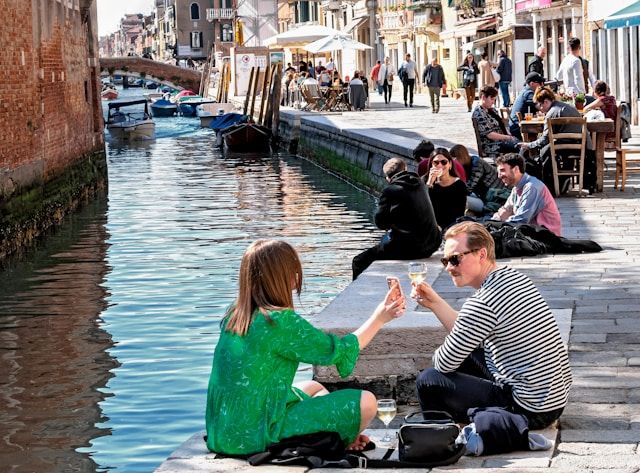If you’re looking to uncover every hidden corner of Serenissima, today I’ll guide you through Cannaregio Venice, one of the city’s most fascinating and authentic neighborhoods.
It’s less crowded than iconic spots like St. Mark’s Square and preserves the real spirit of historic Venice, with quiet canals, peaceful alleys, and a daily life that still follows ancient rhythms. Ready to explore?
What does Cannaregio mean? Meaning

Let’s start with a question many travelers find intriguing: what does “Cannaregio” mean? The name “Cannaregio” derives from the presence of reed beds, or "canna" plants, that once filled this lagoon area.
Another theory suggests it may come from “canal regio” (meaning "royal canal"), a name referring to the important waterway that connected the lagoon to the city. This district, therefore, brings with it a bit of ancient Venice, tied to the lagoon’s nature and watery rhythms.
How to reach the Cannaregio District in Venice?

If you’re already in Venice, reaching Cannaregio is very simple. Here are some tips to get you right to the heart of this district.
- By Foot: From the Santa Lucia train station, Cannaregio is just a few minutes’ walk. Cross the Ponte degli Scalzi and go straight until you reach Calle de la Misericordia, the main street of the district.
- Vaporetto: The most typical and enjoyable way to get around is by vaporetto. Lines 4.1, 4.2, and 5.2 run along the Grand Canal and will take you into Cannaregio. The most convenient stops to explore Cannaregio are "Guglie" and "San Marcuola-Casino."
Where Is the Cannaregio District in Venice?

Cannaregio Venice is in the northern part of Serenissima, bordering the lagoon. The district is bordered by the Grand Canal to the east and by the Castello district to the west. Not far from the train station and just a few steps from the Jewish Ghetto, Cannaregio is one of the city’s most populated and lively areas, with a truly genuine atmosphere.
Map and Postal Code
Cannaregio Venice covers a broad portion of the city, from Piazzale Roma to the San Marcuola area, with the main postal code 30121. A map will help you explore every corner, but you can also let yourself be guided by the charm of little-known alleys, bridges, and canals.
Distance from Cannaregio to St. Mark’s Square
The distance from Cannaregio to St. Mark’s Square is about 20–25 minutes on foot. If you prefer a journey by water, take a vaporetto along the Grand Canal: in less than 15 minutes, you’ll be right at the foot of the famous square.
Cannaregio, Venice Hotels
Staying in Cannaregio Venice is a great choice for those wanting to experience Venice away from the main tourist flows. Here you’ll find a variety of accommodations, from luxury hotels to charming Venetian inns. Some of the best hotels in Cannaregio Venice include:
- Ca’ Sagredo Hotel: This luxurious hotel in a historic palace offers a stunning view of the Grand Canal and elegant interiors rich in artwork.
- Hotel Antico Doge: Located in a medieval palace, it’s a perfect choice for those looking for an authentic and romantic atmosphere.
- Ai Mori d’Oriente: A chic, relaxing boutique hotel inspired by Venice’s historical ties to the East.
Cannaregio Venice Restaurants
Eating in Cannaregio Venice is an authentic experience that lets you discover traditional Venetian flavors. Here are some of the best restaurants in the district:
- Alla Madonna: A historic trattoria serving fresh seafood dishes, including classic spaghetti alle vongole and fegato alla veneziana (Venetian-style liver).
- La Cantina: This casual wine bar is perfect for tasting delicious cicchetti (traditional Venetian appetizers) paired with a glass of wine.
- Al Timon: A lively spot along the Misericordia Canal, known for grilled meats and a unique atmosphere, where you can dine aboard a boat.
Residents of Cannaregio Venice
Cannaregio Venice is one of the most populated districts of Serenissima, with around 13,000 residents (2007). It’s a vibrant, authentic area where many Venetian families still live and work. Here, you’ll meet fishermen, artisans, and see everyday Venetian life unfolding between markets, shops, and small squares.
Physical geography Cannaregio Venice
Cannaregio Venice stretches across a flat area crisscrossed by numerous canals that create a picturesque landscape. Besides the Grand Canal, main waterways include the Cannaregio Canal and Rio della Sensa. Cannaregio’s geography is characterized by many small alleys, open squares, and bridges, making it one of the city’s most scenic areas.
History of Cannaregio Venice Italy
Cannaregio Venice has a long and fascinating history. Originally a marshy area, it began developing as a residential and commercial hub in the 14th century, thanks to the Cannaregio Canal, one of the city’s main waterways. In 1516, the first Jewish ghetto in the world was established here, a site of significant historical and cultural importance that still preserves traces of its ancient Jewish community.
Cannaregio Venice: Monuments and landmarks
Cannaregio Venice is full of monuments and landmarks worth visiting:
- Jewish Ghetto: The historic heart of Venice’s Jewish community, with synagogues, museums, and a square that evokes a unique and evocative atmosphere.
- Ponte dei Tre Archi: One of Venice’s most beautiful and distinctive bridges, featuring a three-arch structure that spans the Cannaregio Canal.
- Ponte delle Guglie: Another iconic bridge, decorated with spire-like pinnacles that give it its name.
- Campo del Ghetto Nuovo: A historic square surrounded by old buildings where you can visit the Jewish Museum and learn more about the ghetto’s history.
Cannaregio Venice: Churches
Cannaregio is home to some of Venice’s oldest and most significant churches:
- Church of the Madonna dell’Orto: A Gothic church famous for the works of Tintoretto, who is also buried here.
- Church of San Geremia: Known for housing the relics of Saint Lucy, a saint venerated by Venetians.
- Church of Sant'Alvise: Unique for its Baroque architecture and frescoes by artists like Tiepolo.
Cannaregio Venice: Palaces
The palaces in Cannaregio are fascinating testaments to Venetian history:
- Palazzo Labia: One of Venice’s most spectacular buildings, with interiors frescoed by Giambattista Tiepolo.
- Ca’ d’Oro: Although not located directly in Cannaregio, it’s nearby and one of the most admired palaces along the Grand Canal.
- Palazzo Soranzo Van Axel: A Gothic palace with a charming internal courtyard, less known but full of charm.
Cannaregio Venice: Exploring the hidden charms of Venice’s northern District
The Cannaregio Venice district holds some of the city's most enchanting corners, offering an authentic escape from the touristy areas. A walk through Cannaregio means immersing yourself in a residential Venice still rich with tradition, where local residents go about their daily lives. This area is perfect for those wanting to explore the north of the city away from the crowds. Grab la mappa con gesti (the map with gestures) or check Google Maps, then stroll through charming canals, houses, and restaurants for an unforgettable experience.
Grand Canal
One of the most important monuments in Venice is, without a doubt, the Grand Canal. This famous canal runs right along the edge of Cannaregio, offering stunning views of palazzi and historic houses. From sunset to sunrise, the Grand Canal showcases some of the city’s most beautiful examples of Venetian architecture, including Palazzo Santa Sofia and the legendary Ca' d'Oro. For a true taste of Venice, hop on a vaporetto and cruise along the canal, spotting paintings and intricate façades that tell the history of several centuries past.
Train Station: Santa Lucia, your gateway to Cannaregio Venice
The train station of Santa Lucia is the main point of entry for anyone arriving in Venice by rail. Located just steps away from the Cannaregio district, the train station connects travelers to the city with ease. From here, you can explore Venice in all its richness: Jewish Ghetto with its five synagogues, Madonna dell'Orto Church, and the vibrant local street life of Cannaregio. The location is ideal, giving tourists immediate access to hidden gems like Campo dei Mori and Tintoretto’s House.
Santa Maria dei Miracoli: A jewel of venetian renaissance
The Santa Maria dei Miracoli church is one of the most important monuments of Cannaregio Venice, known for its stunning façade and refined interior that exemplify Venetian Gothic architecture. Built in the late 15th century, this church is dedicated to the Virgin Mary and holds an iconic Madonna painting, believed to have miraculous powers. The structure is a feast for the eyes, with delicate arches, colored marble, and beautiful artworks that add to its timeless charm. Visiting Santa Maria dei Miracoli offers a glimpse into the grandeur of Venetian art and culture.
Rialto Bridge and Cannaregio Venice
No visit to Venice is complete without experiencing the iconic Rialto Bridge. Located just south of Cannaregio Venice, the Rialto Bridge connects the district with touristy areas and offers an impressive view of the bustling Grand Canal. Built in 1591, the structure remains one of Venice’s most important monuments and an emblem of Venetian resilience and architectural prowess. From the Rialto Bridge, you can easily reach Teatro Italia and other hidden gems of Cannaregio, exploring further the city’s ancient walls and art treasures that have survived for several centuries.
Jewish Museum and the Jewish Ghetto: A unique part of Cannaregio Venice
Cannaregio’s Jewish Ghetto is an area filled with deep history and Jewish culture, home to the Jewish Museum, which houses fascinating artifacts that trace the lives of Venice's Jewish community. Known as the world’s first official Jewish Quarter, this area preserves its identity with five synagogues from different traditions and backgrounds. Exploring the Jewish Ghetto offers a chance to learn about jews in Venice, their heritage, and their impact on Venetian art and culture over several centuries.
Madonna dell’Orto Church: A gothic gem in Cannaregio
The Madonna dell'Orto Church is one of Cannaregio Venice’s hidden treasures, renowned for its Gothic design and paintings by Tintoretto, who lived nearby. This church is dedicated to the Virgin Mary and features a beautiful façade and stunning interior filled with frescoes and paintings that narrate the history of Venice. Known for its peaceful atmosphere, it’s a perfect spot for a quiet visit away from the crowds and a must-see for art lovers seeking some of Venice’s most important monuments.
FAQ about the Cannaregio District, Venice, Italy
How long does it take to explore Cannaregio?
Cannaregio deserves at least a full day, especially if you want to visit museums, churches, and enjoy local cafés and restaurants.
What is the best time to visit Cannaregio?
Cannaregio is delightful year-round, but in spring and fall, you’ll enjoy mild temperatures and a more relaxed atmosphere.
Is it possible to take a gondola ride in Cannaregio?
Yes! Cannaregio offers many spots for gondola rides through its picturesque canals, which are less crowded than the Grand Canal.
Is it family-friendly?
Yes, Cannaregio is perfect for families: there are many parks, peaceful spaces, and restaurants suitable for children.
Cannaregio, with its fascinating history, ancient architecture, and authentic atmosphere, is a district that invites you to lose yourself and discover the true essence of Venice. It’s not just a place to visit, but a place to experience an unforgettable, genuine Venetian adventure. Enjoy your journey, explorers.

